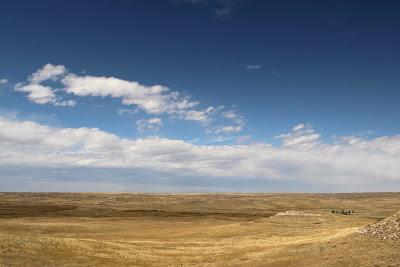 Can you see them? those spectral wagons winding down, ruffling the grass?Can you hear them? those murmurs and whispers, sounding like the wind?They’re coming, singing the old songs.
Can you see them? those spectral wagons winding down, ruffling the grass?Can you hear them? those murmurs and whispers, sounding like the wind?They’re coming, singing the old songs.In May of 1908, an old man and his entourage again traveled by wagon over 95 miles of rough dirt roads to a ranch on the Niobrara River in northwest Nebraska, as they had done many times. This time he delivered to his good friend of 30 years a formal written request bearing five signatures and three witnesses:
“… I will soon go to join my oId friends and now on my last visit to you my friend I want to say through my nephew and interpreter Mr. Phillip Romero that in you I think my people will always find a true friend and I want them to listen to your words of council.”Red Cloud was 85 or 86 years old, almost dead—which he knew to be the case because his mother and father often came and spoke to him. That last trip was his final effort to preserve something of the old times, of people and a culture that would soon be gone. He made very clear what he expected of James Cook:
“I want you to always own and keep that picture—as long as you live, and then let your oldest son have it to keep. Then I am sure my children and their children can always go and look at the face of one of the last of the old Chiefs that lived before the white men came to take our lands and turn us from the old trails we had followed for so many hundreds of years.”
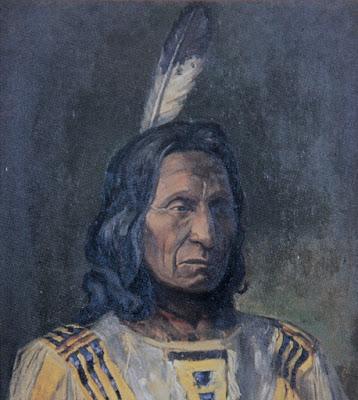
Red Cloud sat for artist Bessie Butler (1) at James Cook’s ranch in 1902 (from NPS exhibit).
Red Cloud died less than a year later. It was the end of a long life spanning a sweeping difficult transition. As a young man Red Cloud was a powerful warrior, first in battles with other tribes and then against the US Army (2). But when he saw the inevitability of defeat, he turned to negotiation. He actively advocated for his people into even old age, and in spite of repeated betrayal and disappointment. Perhaps it’s a testament to the strength of his determination that his 1908 directive to Cook was executed as specified—and then far beyond anything even Red Cloud could have envisioned.Red Cloud and James Cook first met in 1874, at the Red Cloud Agency in western Nebraska. Red Cloud was 53 and chief of the local Oglala Lakota band (not chief of the Sioux Nation as is often said). Cook was only 17 but already well-respected as a hunter and guide. They were introduced by Baptiste “Little Bat” Garnier, a resident of the agency and friend of Cook. Something clicked, launching a friendship highly unusual for the times, between two men most would expect to be archenemies.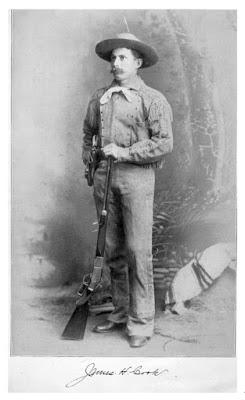
James Cook, age 29 (NPS 2011).
By 1887, Red Cloud and the Oglala Lakota had been moved to the Pine Ridge Reservation in South Dakota, and James Cook had married and taken over his father-in-law’s place on the Niobrara River, which he renamed the Agate Springs Ranch. For some thirty years, he obtained the requisite passes so his Indian friends could leave the reservation. After three to five days or a week of travel (95-150 miles one way, accounts vary), they wound down the hill to the Niobrara River bottom, singing songs, especially one about Cook whom they called Wambli Cigala.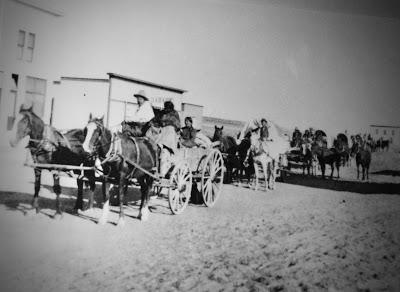
En route from Pine Ridge Reservation to Agate Springs Ranch, 1915 (from NPS exhibit).
Once on the ranch, they were able to return to the old ways. After setting up tipis, they hunted pronghorn antelope, tanned hides, held traditional dances and ceremonies, and—joined by Cook—spend hours recounting stories of the old days. Cook provided fresh vegetables and freshly-killed beef.The Indians always brought gifts—in appreciation, but also to preserve them and their stories by leaving them with Cook. Some were newly-made specifically for the Cook family—intricately beaded moccasins, beautifully decorated buckskin clothing of exquisite suppleness, and three tipis, including a half-size one for the children. Other items were utilitarian, documenting the old ways—ladles, hide scrapers, a porcupine hairbrush and mirror, saddlebags and parfleches (rawhide boxes). The most valuable gifts were personal belongings “no longer in use but with great meaning” such as pipe bags, shields, charms, and Red Cloud’s shirt.
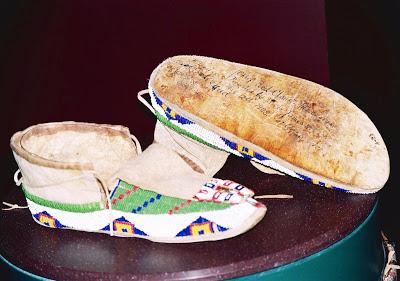
Beaded moccasins made for James Cook (these five photos are from NPS photo galleries).
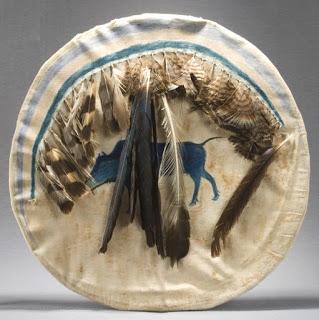
Nameplate for tipi.
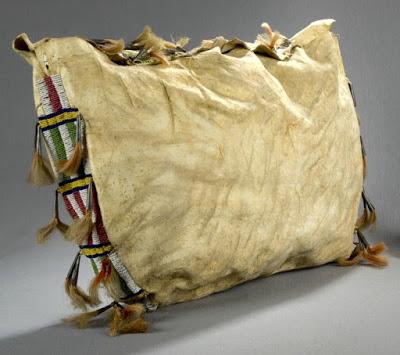
Leather saddle bag with beads and metal tassels.
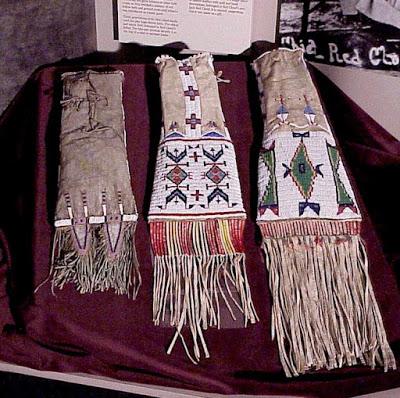
Three pipe bags belonging to Red Cloud (center), his father (left) and his son Jack (right).
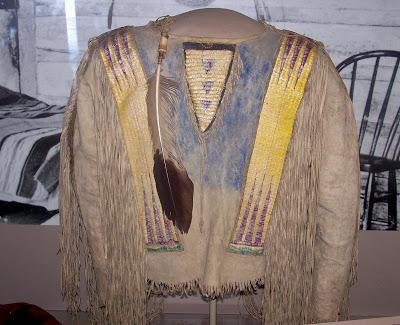
Red Cloud’s shirt of supple deerskin, with purple and gold porcupine quillwork.
It was all so improbable … a white rancher in rural Nebraska encouraging and preserving traditional Indian culture at the same time that the US government was explicitly eradicating it, through destruction and assimilation. And Cook didn't just preserve artifacts and stories. He created a public museum at the ranch, reaching out to promote Indian culture, and counter the many misconceptions. (It also included fossils from the amazing quarries nearby.) By 1910, there were so many visitors that son Harold, his wife, and his children were recruited to help James with tours (Dorothy Cook Meade tells stories of being a child museum guide in her book, see Sources below).After James Cook’s death, son Harold maintained the collection at the ranch. After his death, it was given to the National Park Service. The visitor center at Agate Fossil Beds National Monument has two rooms dedicated to the Cook Collection. Now Red Cloud’s portrait is viewed by “children and their children” from far and wide. What goes through their minds when they “look at the face of one of the last of the old Chiefs,” and view the gifts and old photos, and read the stories?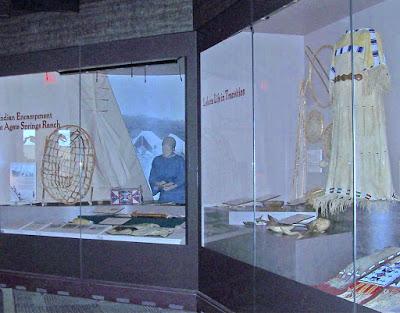
Cook Collection exhibit (NPS 2011).
In September, I made a second trip to Agate Fossil Beds National Monument, specifically to view the Cook Collection (on my first visit I got caught up in the spectacular paleontology and ran out of time). The Red Cloud – Cook display occupies a darkened room, with gifts, old photos and stories illuminated. It felt other-worldly, which I liked (3). Of course I would have preferred hearing the stories from James Cook himself, in the den of his ranch house. Best would have been to visit when the old people were there—hunting, dancing and singing. But those days are gone forever. So after viewing the exhibit, I walked along one of the prairie trails, looking and listening, trying to imagine the old ways.
Can you see them?
(1) The Red Cloud portrait was painted by Bessie Sandes Butler, a classmate of Kate Cook (wife of James) who “happened to be” visiting. She was a graduate of the Chicago Art Institute (Meade 1994).
(2) Red Cloud led one of the few Indian victories against the US Army, in his defeat of Fetterman’s column in December 1866. The fear he instilled in local garrisons led to the Fort Laramie Treaty, an amazing achievement at the time, but broken just two years later (source).(3) My one criticism of the exhibit is that the drumming and chanting playing much of the time was too loud. It took away from the other-worldly feeling … from communing with spirits. Next time I'll use inconspicuous ear protectors.Sources
Baird, MF, and Knudson, R. 2008. In the spirit of old friends: reflections on repatriation at Agate Fossil Beds National Monument. Heritage of the Great Plains XLI–2.Meade, DC. 1994. Heart bags & hand shakes; the story of the Cook Collection. National Woodlands Publ. Co. [Dorothy Cook Meade is a granddaughter of James Cook]
PBS.org. 2001. Red Cloud, in New perspectives on the West. https://www.pbs.org/weta/thewest/people/i_r/redcloud.htm (accessed January 2018).
National Park Service (NPS). 2011. Agate Fossil Beds National Monument Long-Range Interpretive Plan. PDF
